
Dinosaurs are the most incredible beasts. They have captured the public’s imagination for over 100 years, but whilst all Dinosaurs were in their own way unique and interesting, I’ve still decided to take a look at my top 30 Dinosaurs. I will be looking at just how deadly the meat eaters really were, how big the largest plant eaters got, debunk some famous myths and finally look at their most famous depictions in popular culture.
As always let me know what you think in the comments below.
30/ Dilophosaurus

Name Meaning: Two Crested Lizard
Size: 23 feet in length, 400 kilograms in weight
Prey: Prosauropods
Fossil Range: Middle Jurassic
Dilophosaurus was a medium sized carnivore, though it would have been the largest meat eater in its territory.
Originally thought to be nothing more than a scavenger dues to its apparently weak jaws, more recent studies have shown that Dilophosaurus teeth were stronger than previously thought.
It is believed that Dilophosaurus may have been like a lethal reptillian Kangeroo, jumping up and down on its tail, slashing at victims with its massive claws and then biting them. It has also been speculated that much like the later Spinosaurus, Dilophosaurus used its claws to scoop up fish.
The two famous crests on the beasts head were very delicate and so would not have been used in any form of defence. Instead they may have been used to help it attract a mate or to cool down in the hotter climates.
In Popular Culture
Dilophosaurus was featured in Michael Crichton’s classic novel Jurassic Park and the subsequent film adaptation. Here however it was depicted as being much smaller and having the power to spit poison and a massive frill.
In many ways the Jurassic Park version was more terrifying than the real animal.
Sadly whilst this horrifying sequence is one of the most iconic from the original Jurassic Park, the Dilophosaurus, save for a tiny cameo as a hologram in Jurassic World, has yet to appear in any of the sequels.
I’d personally love to see a fight between a pack of Dilophosaurus’ and Velociraptors.
The success of Jurassic Park has meant that whenever Dilophosaurus does appear its often the Jurassic Park version rather than the real one. I can understand in a way, as from a story perspective, the spitting Dilophosaurus is a more unique and terrifying animal.
Still it would be nice to see the actual Dinosaur get a chance in the limelight too.
29/ Carnotaurus
Name Meaning: Meat Eating Bull
Size: 29 feet
Prey: Sauropods
Fossil Range: Late Cretaceous
Carnotaurus was a member of the Abeliosaur family. Famous for its distinctive appearance, Carnotaurus was the only meat eating Dinosaur to have two horns above its eyes.
Its arms were the smallest of any meat eater (even more so than T rex.) Recent studies however have shown that it had one of the strongest bites of any non Tyrannosaur Dinosaur.
Carnotaurus bite may have been over 3 tons, which would have easily enabled a Carnotaurus to bite an animal the size of a human in half no problem. It may also have been able to partially dislocate its jaws like a snake too.
In addition to this Carnotaurus was also one of, if not the fastest large meat eater. It is believed that it could run at over 40 mph, which is faster than any animal of a similar size today, such as a Rhino, or an Elephant.
Finally its horns may have been used more for fighting for mates than for hunting, but whatever the case they were very strong and would have acted as shock absorbers when the animal attacked its victim.
In Popular Culture

Due to its unusual look, Carnotaurus has become quite a popular Dinosaur in films and video games. Undoubtedly its most prominent role was in the 2001 Disney animated movie, Dinosaur, where it was the main antagonist. Apparently the standard Tyrannosaurus was to have been originally used, but the films makers at the last minute decided to switch to a Carnotaurus simply because they thought it looked better.
The Carnotaurus in this movie was obviously made much larger than the real animal.
Carnotaurus has long been associated with the Jurassic Park franchise too. It plays a significant role in the novel of The Lost World, where it is given the ability to camoflauge.
Despite this however it didn’t make an appearance on screen until Jurassic World Fallen Kingdom where it fell victim to a Tyrannosaurus Rex.
28/ Megalosaurus
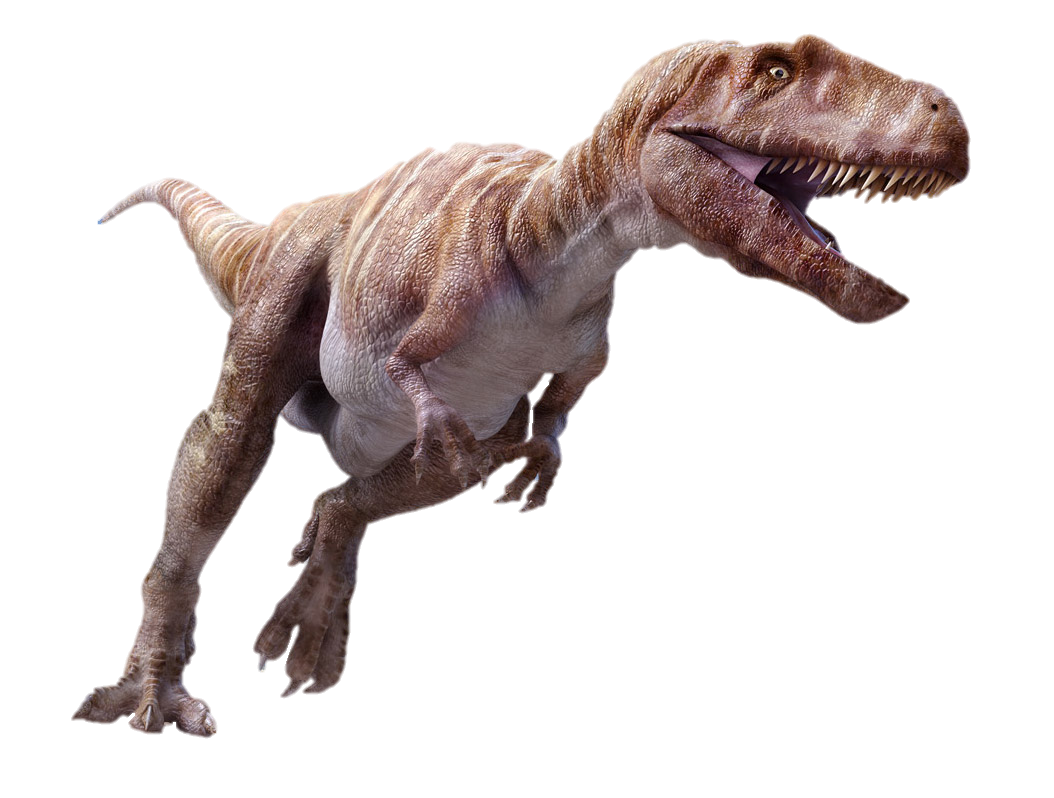
Name Meaning: Great Lizard
Size: 30 feet
Fossil Range: Middle Jurassic
One of the original giant meat eating Dinosaurs, Megalosaurus was also fittingly one of the first Dinosaurs to ever be discovered. In fact Megalosaurus was discovered long before the name Dinosaur was even conceived.
Somewhat paradoxically however a full skeleton of Megalosaurus has never been found. Still from its remains, scientists can gather a fairly accurate picture of what the beast would have looked like.
Megalosaurus had a somewhat more sturdier build than many other meat eating Dinosaurs, with its arms in particular being much more muscular than those of other theropods.
Still in many ways Megalosaurus is a reminder of just how little we know about the ancient world, as we have had fossils of this creature for over 100 years, yet we still can’t say for sure what it would have looked like.
In Popular Culture
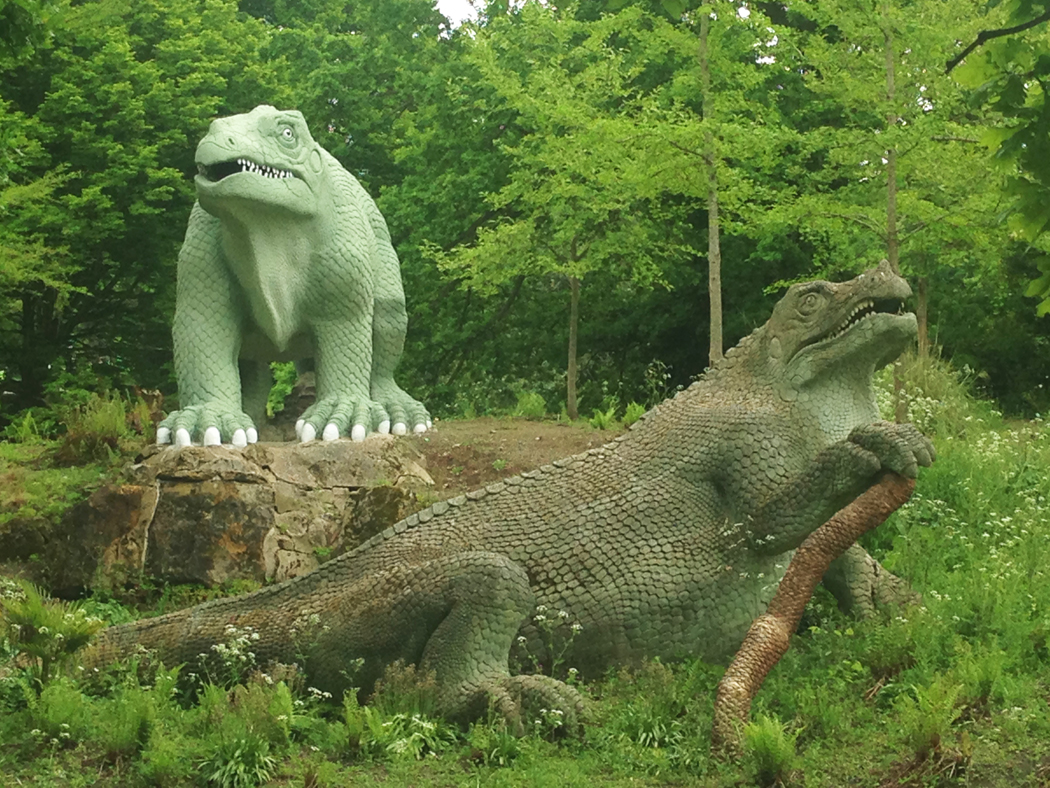
Megalosaurus was possibly the first Dinosaur to be referenced in popular culture. In Charles Dickens famous novel, Bleak House he mentions.
“Implacable November weather. As much mud in the streets as if the waters had but newly retired from the face of the Earth, and would it not be wonderful to meet Megalosaurus, forty feet long or so waddling like an elephantine lizard up Holborn Hill.”
Several statues of Megalosaurus and other giant Dinosaurs like Iquanodon were built in the Crystal palace. However in the century since the models are now considered woefully inaccurate, though they can of course still be appreciated as pieces of art.
Megalosaurus also was listed as being one of the candidates for the giant meat eating Dinosaur that stalks our main heroes in Sir Arthur Conan Doyle’s Lost World. Professor George Challenger mentions that the monster could be either Megalosaurus or Allosaurus, though certain reprints and editions will just choose one Dinosaur.
As larger and more ferocious Dinosaurs were discovered in the ensuing decades such as Allosaurus, Tyrannosaurus Rex and of course Spinosaurus, then Megalosaurus began to fade from the public’s consciousness, though it does still occasionally feature in some works of fiction such as the Jim Henson series Dinosaurs, where a Megalosaurus is the main character and the video game ARK.
27/ Baryonyx
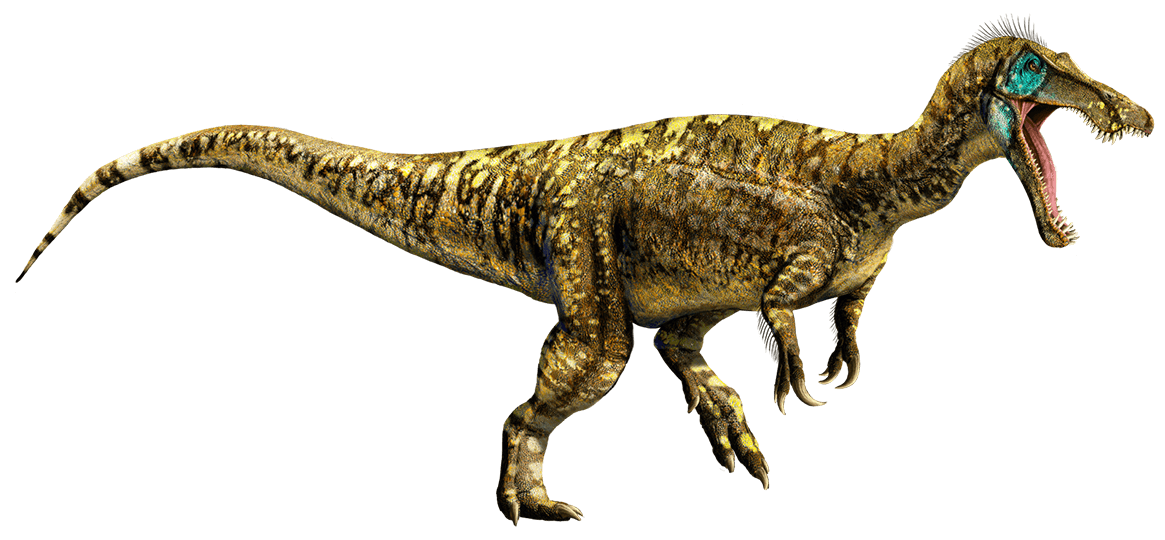
Name Meaning: Heavy Claw
Size: 33 feet in length, 2 tons in weight
Diet: Primarily fish, other smaller Dinosaurs, Pterosaurs
Fossil Range: Middle Cretaceous
A medium sized member of the Spinosaur family of Theropods. Baryonyx had a somewhat more unusual appearance than most other meat eating Dinosaurs with its long Crocodile like snout, longer arms and larger claws on its hands.
Most experts believe that Baryonyx was like the Dinosaur version of a large grizzly bear, living by lakes, using its claws to scoop up fish and snatching smaller prey. Whilst its diet appears to be mostly fish, there is some evidence that it fed on smaller Dinosaurs, with the remains of a baby Iquanodon, a plant eating Dinosaur having been found in its stomach.
Baryonx would have killed its prey by using its long claws to pin its victims down whilst it bit them. It claws may also have been used to disembowel its victims.
It is possible that Baryonyx may have had a semi aquatic lifestyle and moved on all fours like its much larger cousin Spinosaurus, but there is no concrete evidence for this yet.
In Popular Culture

Baryonyx’s most notable appearance in popular culture is in the movie Ice Age 3 Dawn of the Dinosaurs.
Set in a lost valley below the ground where Dinosaurs still roam, the Baryoynx who is named Rudy is the main antagonist of the movie, and is shown to be even larger than the Tyrannosaurus Rex, Big Momma, who is actually scared of Rudy.
Ultimately however in tradition with many other Dinosaur movies such as Jurassic Park, the T rex makes a heroic appearance at the end and saves the main characters by pushing Rudy off a cliff (though he survives and even cameos in the next entry in the series.)
Baryonyx also recently appeared in Jurassic World Fallen Kingdom.
26/ Ceratosaurus

Name Meaning: Horn Lizard
Size: 23 feet long
Prey: Smaller herbivores, possibly larger prey in packs.
Fossil Range: Mid to late Jurassic
A small to medium sized meat eater from the Jurassic era. Ceratosaurus is most famous for the single horn on its nose, a unique feature among meat eating Dinosaurs. Whilst many initially assumed that Ceratosaurus used this horn as a weapon, it is now primarily believed to have been used for a mating display.
Small, nimble and agile Ceratosaurus most likely preyed on smaller herbivores or infants of larger creatures like Diplodocus or Brachiosaurus. Some experts believe that Ceratosaurus may also have been a pescavore too.
Ceratosaurus shared its environment with Allosaurus, a much larger and more powerful therapod. It has been suggested that these two predators sought different prey in order to avoid conflict with one another. It is worth mentioning that contrary to how it is often portrayed in documentaries where Allosaurus drove Ceratosaurus to extinction. Both animals were able to co-exist for millions of years together, again suggesting they occupied different niches.
In Popular Culture
Ceratosaurus has been featured in many movies and pieces of Dinosaur fiction. Due its more distinct appearance it often became the other giant meat eater after Tyrannosaurus and Allosaurus.
Its most notable appearance in films was arguably the Ray Harryhausen movie One Million Years BC where a Ceratosaurus was shown to fight a Triceratops before being gored to death.
Of course just as in other films the Ceratosaurus is shown to be far larger and more powerful. There is no way a real life Ceratosaurus would be able to even hold its own against a Triceratops (not that the two creatures would have ever met of course, but then again One Million Years BC is a fantasy film anyway.)
Some of Harryhausen’s best work. This scene would often be used in documentary’s about Dinosaurs to demonstrate how a Tyrannosaurus and Triceratops would have fought each other.
25/ Velociraptor
Name Meaning: Swift Robber
Size: 7 feet long
Diet: Mammals, small herbivores, baby Dinosaurs
Fossil Range: Late Cretaceous
Velociraptor is of course one of the most famous Dinosaurs of all time. In fact its arguably the second most famous Dinosaur after Tyrannosaurus Rex.
The image of Velociraptor in popular culture is quite different to the real animal. Velociraptor is often depicted as a 6 foot tall, scaly man eater, hunting in packs to bring down giant Dinosaurs like Sauropods, and slicing its prey open with is sickle like claw.
In reality however Velociraptor was the size of a Wolf, covered in feathers and its claw was incapable of disembowling, or even penetrating the hard skin of a modern day Crocodile, never mind a giant Sauropod.
It is also not even known for sure if Velociraptor hunted in packs either. Modern day relatives of Dinosaurs, birds and Crocodillians are not shown to be able to work together with the same level of co-ordination as say wolves. They can however temporarily swam together to overwhelm large prey, and its entirely possible that Velociraptor would have done so too. Still there is actually no more evidence for Velociraptors even hunting in this more loose way together, than there is for any other meat eating Dinosaurs.
Nevertheless Velociraptor was still a fearsome killer. It preyed on smaller Dinosaurs like the pig sized Protoceratops as well as baby Dinosaurs of giants like Ankylosaurus.
As to how Velociraptor killed its prey, its believed that it stabbed its sickle like claw into its victims throats and slowly choked them to death.
Evidence for this comes from a truly incredible fossil of a Velociraptor and a Proteceratops caught fighting each other. How these two animals were suddenly killed in the middle of fighting no one knows, but it seems likely they were buried under a sand storm which would have also helped to preserve the two Dinosaurs as well.

You can see how the Raptor in its final moments is thrusting its claw into the herbivores neck to try and escape.
Another way that Velociraptor could have killed its victims would have been to climb to the top of a tree, and glide down like a bird of prey onto its unsuspecting victims back. Its jaws were very strong for an animal of its size and whilst the talons on its feet and hands held its prey down, the Raptor would have eaten them alive!
Velociraptor was also among the most intelligent species of Dinosaurs. It is known that some Dinosaur species, such as Tyrannosaurus Rex were more intelligent than some modern day species of apes, and so in this respect Velociraptor’s intelligence may very well have rivalled among the most intelligent mammals around today.
In Popular Culture
Velociraptor’s most famous appearance in popular culture was of course in Michael Crichton’s novel, and subsequent film adaptation, Jurassic Park.
Following the success of Jurassic Park, Raptors would go on to appear in countless other works of fiction in exactly the same way, as tall, scaly, fiendishly clever, pack hunters, with disembowling claws.
The actual Dinosaur in Crichton’s Jurassic Park was based on Deinonychus, a larger relative of Velociraptors. At the time Crichton was writing, Deinonychus was actually believed to be a member of the Velociraptor family, but this has since been disproven.
Had it not been for this error then Crichton would have most likely used Deinonychus, and Velociraptor, which was discovered as far back as the 1920s would have continued to remain obscure. Thanks to a small error however Velociraptor has now become the second most famous Dinosaur of them all.
24/ Dryptosaurus

Name meaning: Tearing Reptile
Size: 24 feet long, over 1 ton in weight
Prey: Hadrosaurs
Fossil Range: Late Cretaceous
Dryptosaurus was a member of the Tyrannosaur family of Dinosaurs. Originally smaller meat eaters, the Tyrannosaurs gradually grew to be the largest and dominant family of meat eating Dinosaurs, out competing other large groups of meat eaters to extinction anywhere they appeared.
Dryptosaurus however was still a relatively smaller Tyrannosaur, though it would have had a stronger bite than any animal alive today, and would have most likely been very fast too. It could possibly have run up to 35 miles per hour, which is faster than modern day carnivores like Tigers and Lions.
What Dryptosaurus lacked in size, it would have made up for in intelligence, speed and power.
In Popular Culture

Dryptosaurus was featured in the works of artist Charles R Knight (whose paintings of prehistoric creatures later inspired the works of Willis O’Brien and Ray Harryhausen.)
Knight’s painting depicted Dryptosaurus as an active, fleet footed creature moving in a more bird like stance.
At the time such ideas were not widely held by the scientific community. Dinosaurs were thought of as slow moving, stupid, obsolete creatures destined for extinction. This painting of the two fighting Dryptosaurus however challenged that assumption and would later be influential in reconstructions of similar, smaller bird like Dinosaurs such as the Velociraptors in Jurassic Park.
Sadly however despite this Dryptosaurus appears to have been left out of most films, television series and comic books about Dinosaurs. Personally I think it would make a great antagonist as it’s kind of like a combination of a T rex and a Raptor.
23/ Centrosaurus

Name Meaning: Pointed Lizard
Size: 19 feet long
Diet: Plants
Fossil Range: Mid Cretaceous
Centrosaurus was a medium sized Ceratopsian Dinosaur. It had a single horn on the tip of its snout and a massive frill. Like most Ceratopsians it was able to defend itself against the majority of meat eating Dinosaurs, but was still preyed upon by Tyrannosaurs, such as Daspletosaurus (believed to be the ancestor of Tyrannosaurus Rex.)
The horn on the Centrosaurus was used for defence, but its frill was soft and weak and so therefore was most likely used to attract mates.
Whilst nowhere near as large or powerful as the more famous Triceratops, there still have been far more skeletons of Centrosaurus discovered than of Triceratops and so it appears to have been a very successful animal.
Despite this however as there were so many similar and closely related species, then trying to figure out which animals were merely closely related and which were actually specimens of Centrosaurus has been somewhat difficult for experts.
Monoclonius for instance was a famous Ceratopsian Dinosaur, often featured in popular culture that was thought to be a relative of Centrosaurus until recently, where it was revealed to just be a specimen of Centrosaurus itself.
In Popular Culture
Centrosaurus has been featured in many documentaries about Dinosaurs including the recent Planet Dinosaur narrated by the late John Hurt.
One memorable sequence shows several Daspletosaurus’ attack a herd of Centrosaurus, chasing them into a lagoon where a Deinosochus (a prehistoric crocodile, 40 feet long) carries several of the helpless herbivores away.
Another memorable appearance from the Dinosaur in popular culture was an animated short by Phil Tippet which depicted a Centrosaurus being hunted by a Tyrannosaurus Rex.
The Centrosaurus was actually meant to be a Monoclonius, but since Monoclonius is no longer a valid species, then this technically marks an appearance of Centrosaurus.
Tyrannosaurus did not live at the same time as Centrosaurus, (the Centrosaurus is also a bit bigger too, as obviously a real life Tyrannosaurus would snap a Centrosaurus in half effortlessly.) Still this short titled Prehistoric Beast is absolutely superb.
Not only is the animation still top notch, but this scene also develops a very intense and frightening atmosphere leading up to the Tyrannosaurus Rex’s appearance. It feels almost like a horror movie!
We see the Rex slowly stalk the herbivore through the dark and unrelenting forest. The Centrosaurus is clearly scared, but can’t see anything and as it starts to frantically try and get away, it ends up not only becoming separated from its herd, but unwittingly stumbling into the Tyrannosaur’s nest, where it sees the mangled remains of the Rex’s previous kill. The Centrosaurus is too scared at the sight to even notice the Rex creeping up on it.
When the two fight you are led to think that the Centrosaurus might just have a chance, the way it is able to stab the Tyrannosaurus in the leg, but when the monster just shrugs it off and corners the Centrosaurus, you know there is nothing the poor herbivore can do, and its a genuinely disturbing moment when the Rex slowly moves in for the kill.
Its a shame that Centrosaurus’ most popular appearances on film and television involve it being ripped to pieces, but at least it usually doesn’t go down without a fight.
22/ Ankylosaurus

Name Meaning: Armoured Lizard
Size: 29 feet, 8 tonnes
Diet plants
Fossil Range: Late Cretaceous
One of the most iconic Dinosaurs, Ankylosaurus was the largest of the armoured Dinosaurs, and was also among the last to die out. It lived alongside the likes of Triceratops, Tyrannosaurus Rex and Velociraptor.
Ankylosaurus was believed to have had the smallest brain of any large Dinosaur, but it more than made up for this with its reinforced body armour. Even its eye lids were said to have been hardened. The Dinosaurs main weapon however was a huge club on its tail which could swing with a force of over 4 tons.
There is evidence that Anklyosaurus fought with giant meat eating Dinosaurs such as Tyrannosaurus Rex and Tarbosaurus (with specimens of both carnivores having injuries on their legs which were clearly made by Anklyosaurus.)
In addition to this Velociraptors were known to prey on Ankylosaurs young. Just as with modern day Crocodiles, the strong armour hadn’t grown in yet in baby Ankylosaurs and depending on whether or not they were cared for by their parents could have made an easy meal for a crafty Raptor.
Still despite this Ankylosaurus would have been capable of defending itself from most predators and was one of the most dangerous plant eating Dinosaurs.
In Popular Culture
Ankylosaurus is featured fairly regularly in popular culture, though usually just as a background character.
In the BBC series Walking With Dinosaurs, an Ankylosaurus is cast in a more antagonistic role against a heroic mother Tyrannosaurus who tries to defend her young. It’s one of the rare instances of a meat eating Dinosaur being portrayed sympathetically.
Arguably the most famous example of Ankylosaurus in popular culture was in the Godzilla film series. Godzilla’s best friend Angillas, is a mutated Ankylosaurus. Though not the most powerful monster, Angillas is Godzilla’s most loyal sidekick and is always the first by his side.
21/ Oviraptor

Name Meaning: Egg Thief
Size: 7 feet long
Diet: small mammals, small animals
Fossil Range: Late Cretaceous
One of the most famous small meat eating Dinosaurs. Oviraptor was originally believed to be a sneaky egg thief as its skull had been found near the remains of several eggs.
More recent studies have shown however that this assumption was unfair as the eggs near the Oviraptor skull were actually its own, and it was in contrast to what its name would suggest, a protective mother.
Oviraptor like many small meat eaters was also a warm blooded creature, covered in feathers and extremely fast and agile. Its strong beak would have enabled it to crush the bones of its prey.
In Popular Culture
Oviraptor has most frequently appeared as a sneaky egg thief in popular culture that meets a gruesome end at the ends of a larger more formidable meat eating Dinosaur, much to the audiences satisfaction.
A classic example of this can be found in the 80s documentary Dinosaur by Christopher Reeve. Here the Oviraptor is shown to steal several Hadrosaur eggs, but after being chased away by the angry mother, the Dinosaur takes a wrong turn and ends up in a dark forest, surrounded by two Deinonychus.
The Deinonychus corner the Oviraptor and tear its guts out. The effects for this sequence supplied by Phil Tippet (who later went to work on Jurassic Park) are stunning, but much like with the Monoclonious sequence from his earlier short, Prehistoric Beast, it’s the atmosphere that really makes it effective. I always had nightmares from the scene where the Deinonychus first roars at the Oviraptor, with is red eye piercing through the darkness, it looks almost like a Demon.
This sequence is also notable for being one of the first ever appearances of smaller pack hunting Dinosaurs like Velociraptor in popular culture and may have even inspired similar scenes in Jurassic Park, (with the Documentary predating both the film and book of Jurassic Park.)
20/ Brontosaurs

Name Meaning: Thunder Lizard
Size: 72 feet long, 20 tons
Diet: Plants
Fossil Range: Mid Jurassic
One of the most famous of all Dinosaurs. Brontosaurus for many decades was believed to be an invalid genus of Dinosaur, after later studies apparently suggest that Brontosaurus was merely a misidentified specimen of an already existing species of sauropod Dinosaur called Apatosaurus. Sadly as a result of this Brontosaurus was deemed invalid, as the first names are usually the ones that are kept in paleontology.
Despite this however the name Brontosaurus persisted in popular culture. Indeed it ironically became arguably one of the most famous Dinosaur names, and the most famous long necked Dinosaur alongside Diplodocus. However in the last year it was discovered that actually the experts had been correct in their original assertion and Brontosaurus was its own separate genus after all.
I personally always preferred the name Brontosaurus to Apatosaurus so I’m glad its back. Its so much more dynamic sounding and it also has a much better meaning “thunder lizard” as opposed to “deceptive lizard” which is what Apatosaurus means.
In Popular Culture
By far and away one of the most famous Dinosaurs, Brontosaurus has appeared in many films, television series and comic books over the years.
It was a regular of the movies of special effects pioneer Willis O’Brien and his protegee, Ray Harryhausen, appearing in their films, the 1925 version of The Lost World, King Kong, The Animal Kingdom and One Million Years BC.
Unquestionably its most famous moment in popular culture is at the end of the 1925 version of The Lost World where a Brontosaurus is brought back to London, only to escape and go on a rampage.
This marked the first ever instance on film of a gigantic prehistoric monster rampaging its way through a large modern city. Godzilla, The Beast From 20000 Fathoms, King Kong and the T. rex from The Lost World Jurassic Park would all follow in the Brontosaurus’ destructive footsteps.
Whilst this is the most famous appearance of Brontosaurus on film, my favourite would have to be in King Kong.
Here the Brontosaurus attacks a group of sailors searching for Kong and Anne Darrow whilst they are crossing a lake. After capsizing their boat, the Brontosaurus kills several of them, before chasing one sailor up a tree who it promptly kills. (Probably not the best place to hide from a giant long necked Dinosaur!)
Whilst the herbivorous Brontosaurus appears to eat the sailors, it is actually just mauling them. Though its still probably a lot more vicious than the actual animal would have been, its nevertheless a brilliant sequence, and I wish more directors had used Brontosaurus as a villain rather than just a large docile grazer. Its massive size, and long serpentine neck that can reach in small places makes it a very effective antagonist, and whilst we don’t know how aggressive these animals were, it is worth noting that many modern herbivores can be extremely territorial such as Elephants and Rhinos.
If any of the sailors were Dinosaur fans then they might have been relieved to see the Brontosaurus at first thinking “oh don’t worry they are friendly” only to get a nasty surprise.
19/ Iguanodon

Name Meaning: Iguana Tooth
Size: 33 feet, 3 tons
Diet: Plants
Fossil Range: Early to Mid Cretaceous
One of the first Dinosaurs to be discovered. Iguanodon was a medium sized (by Dinosaur standards) herbivore that was fairly successful and widespread during the period.
Its size would have scared away most predators, but there is evidence that it fell prey to larger killers including Spinosaurids like Baryonx, and Tyrannosaurids like Eotyrannus. The remains of an Iguanodon have even been found in the stomach of a Baryonx.
However Iguanodon was no pushover when it came to larger predators either. It had a large spike on its thumb which it could have used to bring down some of the deadliest killers around.

In Popular Culture
Iguanodon was one of the first Dinosaurs to be discovered alongside Megalosaurus, and so was one of the first Dinosaurs to be featured in popular culture. Statues were constructed of the beast outside Crystal Palace. Sadly whilst these models were terrific and still hold up as great pieces of art in their own right. They were completely inaccurate, and depicted Iguanodon as a four legged animal with a horn on its nose.
A more accurate early depiction of the animal was in Sir Arthur Conan Doyle’s The Lost World. Here Iguanodon is depicted as a gentle herbivore that is easily slaughtered and hunted by both Allosaurus and the humans of the plateau.
Iguanodon would go on to appear in the 1925 version of The Lost World where it is killed in a fight with an Allosaurus that tears its throat out.
Iguanodon would come to be phased out of popular culture when other, larger, more deadly herbivores such as Triceratops, Ankylosaurus and Brontosaurus began to be discovered.
Still Iguanodon has continued to appear in a few works in recent times, such as most notably Walking with Dinosaurs where it is slaughtered by a pack of vicious Utahraptors.
As is the case with many herbivores. I think its a shame that Iguanodon’s most famous appearances in popular culture, all involve it getting ripped apart by killers like Allosaurus, Giganotosaurus and Utahraptor. It would be nice to see it get a chance to use its spikey thumb at least once on the big screen.
18/ Archaeopteryx

Name Meaning: Old Wing
Size: 1 foot 8 inches in length
Diet: Small mammals and insects
Fossil Range: Mid Jurassic
A very special animal in the history of Paleontology. Archaeopteryx is a missing link between Dinosaurs and Birds.
At the time of its discovery the idea that small, feathery, warm bloodied birds could have descended from giant scaly meat eating Dinosaurs would have seemed ridiculous, but Arechaeopteryx clearly bore many similarities with both modern birds and Dinosaurs.
It had claws on its hands, a sickle like claw on its foot (similar to Dinosaurs such as Velociraptor.) It also had a mouth full of teeth too rather than a beak. Still despite this Archeaoptryx was covered in feathers, had hollow bones just like a modern day bird. (Prior to the discovery of Archeaoptryx, hollow bones and feathers were believed to be features unique only to birds.)
Of course the debate would rage on for many decades after Archeaoptryx’s discovery, but still this small feathered Dinosaur begun the debate, and eventually after the discovery of more transitional fossils, as well as the discovery of many more strong similarities between birds and Dinosaurs, it is now accepted that birds not only evolved from Dinosaurs, but that they are actually classed as a sub group of Dinosaur. Therefore ironically Dinosaurs aren’t extinct. They are all around us today.
17/ Tarbosaurus

Name Meaning: Alarming Reptile
Size: 39 feet long, 8 tons
Diet: Hadrosaurs, Ceratopsians, Anklyosaurs, Sauropods
Fossil Range: Late Cretaceous
Tarbosaurus was a member of the Tyrannosaur family. It was the second largest member of the family after Tyrannosaurus Rex itself.
The similarities between Tarbosaurus and Tyrannosaurus Rex are so great that many believed that Tarbosaurus was actually just an Asian representative of Tyrannosaurus Rex itself!
In Popular Culture
Tarbosaurus has been featured a few documentary’s over the years such as Chased by Dinosaurs, but sadly it was almost always left out of any fictional works about Dinosaurs.
In 2012 however, Tarbosaurus finally landed a starring role in the South Korean film the Dino King, which follows a young Tarbosaurus whose family are killed by a Tyrannosaurus Rex named One Eye. One Eye continues to stalk Speckles throughout the rest of the movie, before their final showdown (see above). Think “The Land Before Time,” except with a Tarbosaurus taking the place of Littlefoot. It’s a decent, if somewhat surreal Dinosaur movie.
16/ Stenonychosaurus
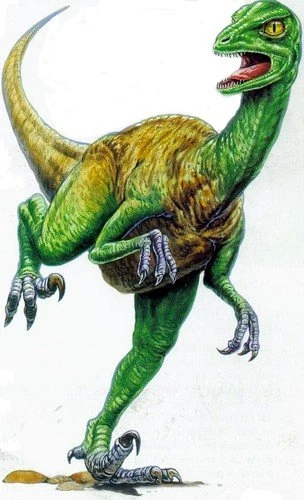
Name Meaning: Narrow Claw Lizard
Size: 6 feet long
Diet: Small mammals, dinosaurs
Fossil Range: Late Creteceous
Stenonychosaurus was a small, bird like Dinosaur that was incredibly fast and agile and had large, sickle like claws on its hands and feet. Its teeth however were relatively small and weak, and many experts believe that it may have been an omnivore.
Stenonychosaurus for many decades much like Brontosaurus was believed to be an invalid genus, with Phil Currie in 1987 reassigning Stenonychosaurus as part of the genus Troodon.
However in 2017 it was recognised as its own separate species, though still as a member of the Troodontid family.
Stenonychosaurus was also believed to be among the smartest of all Dinosaurs, with the Troodontids having the largest brain to body ratios of any Dinosaur species. Its not known for sure how intelligent the animals were, but recent studies have shown that Tyrannosaurus Rex may have been smarter than a Chimpanzee, in which case Troodontod’s intelligence may very well have been on a par with some of the most intelligent animals around today.
In Popular Culture
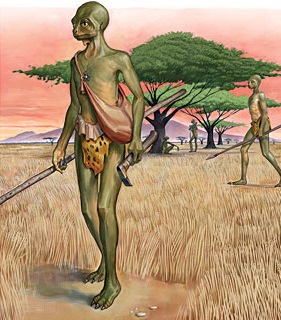
The paleontologist Dale Russell published a thought experiment in 1982 where he argued it was possible that had Dinosaurs not been driven to extinction then small meat eaters like Stenonychosaurus (then thought to be Troodon,) would have eventually evolved into a humanoid like life form, which Dale dubbed “Dinosauroid.”
The Dinosauroid Dale proposed would have communicated in bird song, and would have fed its young through regurtitation like many modern birds.
Sadly Russell’s reputation would suffer somewhat as a result of this outlandish theory, even though it was just intended to be a thought experiment. Still it is an interesting idea nonetheless that has always fascinated me.
The idea of Dinosaurs evolving into humans had actually been featured in fiction before Russell’s thought experiment.
In the classic British sci fi comic, Dan Dare, the main villains, Venusians called the Treens, were said to have evolved from Dinosaur like aliens. Dan Dare’s version of Venus (which was a planet with an earth like atmosphere, teeming with life) was split into two sections through a naturally occurring phenomenon called the flame belt.
On the cooler side of the planet, mammal like life forms evolved, including a race of human like aliens called Therons. On the warmer side of the planet however, Dinosaur like reptiles evolved to become the dominant life form. (Dan even refers to one of them as a Triceratops.) The Treens meanwhile evolved from small meat eating Dinosaurs, and eventually became the dominant life forms on their planet.
The Treens even look like Dale Russell’s Dinosauroid, with their green skins, bald heads, and beak like mouths. However any similarities between the two is coincidental as Dan Dare was never popular in America where Russell was born and raised.


Maybe somewhere across the universe there is a planet where Dinosauroid’s like the Treens are the dominant life forms?
15/ Therizinosaurus

Name Meaning: Scythe Lizard
Size: 33 feet
Diet: plants
Fossil Range: Late Cretaceous
A very strange looking plant eating Dinosaur that looked like a cross between Wolverine and a pigeon.
The three long claws on Therinzinosaurus forearms were the largest ever to exist in any animal (topping even the legendary Spinosaurus’ killing claws.) It is not known exactly what they were for. Many believed that they were primarily used to fend off large predators, but they may have ironically, primarily been used for the mundane task of scrapping leaves off of branches for it to eat.
14/ Gorgosaurus
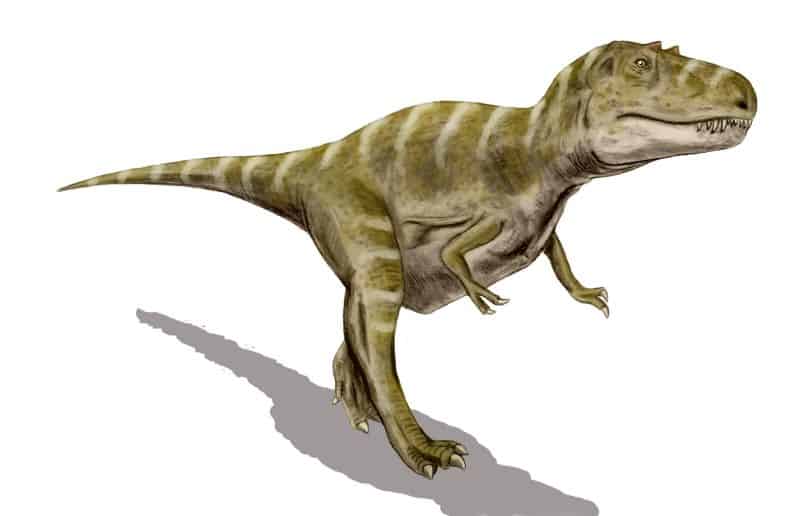
Name Meaning: Dreadful Lizard
Size: 30 feet long, 2 tons
Diet: Hadrosaurs, Ceratopsians
Fossil Range: Mid Cretaceous
Gorgosaurus was a medium sized member of the Tyrannosaur family. Interestingly enough it shared its environment with another large Tyrannosaur, Daspletosaurus (the ancestor of Tyrannosaurus Rex.)
The two large predators however did not compete as they hunted different types of herbivores. Daspletosaurus, that was more heavily built and had stronger jaws, hunted the more heavily armoured Dinosaurs such as the Anklyosaurs and Ceratopsians, whilst the more fleet footed Gorgosaurus hunted the faster Hadrosaurs.
More specimens of Gorgosaurus have been found than of any other Tyrannosaur and so we actually know more about Gorgosaurus than almost any other meat eater including Tyrannosaurus Rex itself.
In Popular Culture
Gorgosaurus appears as the main antagonist in the CGI movie, Walking with Dinosaurs. Based on the popular BBC television series of the same name. This film however was more of a fantasy movie akin to the famous Land Before Time film series, as it featured Dinosaurs being able to talk.
13/ Stegosaurus
Name meaning: Roof Lizard
Size: 29 feet long, 7 tons
Diet: Plants
Fossil range: Mid Jurassic
One of the most famous of all Dinosaurs. Stegosaurus was a relatively simple animal, with one of the smallest brains of any known Dinosaur species. At one point it was actually believed that Stegosaurus’ brain was so small that it needed a second brain, near the back of its legs to control the second half of its body! However subsequent studies have shown that it not only didn’t have a second brain, but that its brain was larger than previously believed, though it was still one of the smallest of any large Dinosaur.
Nevertheless despite it’s limited intelligence, Stegosaurus was also one of the most successful Dinosaur species, lasting for over 10 million years.
Though it was a large herbivore, Stegosaurus was not big enough to scare off the large predators it lived alongside such as Allosaurus. Instead it relied on the 4 spikes on its tail to ward off predators. Each spike was up to three feet long and made of solid bone.
Evidence shows that Stegosaurus and Allosaurus regularly came into conflict with one another, with bite marks made by Allosaurus, that have healed having been found on Stegosaurus skeletons, and Stegosaurus spike marks that have healed being found on Allosaurus skeletons.
Stegosaurus has always been one of my favourite Dinosaurs because of its truly spectacular appearance. The reason for the distinctive plates along its back have been a source of debate among experts with some arguing that they were used as armour, similar to the later Anklyosaurus, whilst others have argued that they may have simply been used to regulate the animals body temperature. Finally another theory is that the plates were used to ward off attackers like Allosaurus as seen in Walking with Dinosaurs.
In Popular Culture
Stegosaurus is one of the most famous and beloved Dinosaurs. It has appeared in some of the earliest fictional works about Dinosaurs and much like Tyrannosaurus Rex, Allosaurus and Triceratops it has continued to be featured regularly since.
Stegosaurus appears in Sir Arthur Conan Doyle’s novel The Lost World, being the first Dinosaur that Challenger discovers on the plateau. It went on to appear in the 1925 version, albeit in a reduced role. Willis O’Brien would also later use Stegosaurus in his masterpiece King Kong.
Stegosaurus also appeared in Fantasia in the iconic Rite of Springs passage. Here it is hunted by a Tyrannosaurus Rex. Following this Tyrannosaurus and Stegosaurus would often be depicted as rivals, despite the fact that Stegosaurus died out millions of years before Tyrannosaurus. There is in fact a greater distance between Tyrannosaurus Rex and Stegosaurus, than there is between humanity and Tyrannosaurus.
The predatory Dinosaur in this sequence was intended to be Tyrannosaurus, despite having three fingers, which Allosaurus, Stegosaurus’ actual predator had. This was apparently because Walt Disney thought the Rex looked better with three fingers.
Stegosaurus would also go on to appear in the likes of Walking with Dinosaurs and the Jurassic Park franchise where it famously attacks Julianne Moore when she gets too close to one of its children.
The Stegosaurus here is depicted as much larger than the real animal.
12/ Styracosaurus

Name Meaning: Spiked Lizard
Size: 18 feet long, 3 tons
Diet: Plants
Fossil Range: Late Cretaceous
An iconic Ceratopsian Dinosaur, Styracosaurus is known from many fossil fragments, and was distinguished by the horns on the top of its frill.
Its not known what the true purpose of its somewhat more extravagant head was. Whilst many believe that its frill and horns were used for defence, others believe that it may have used them to help distinguish one another, or for mating. Its head was so disproportionately large that it may have made Styracosaurus look bigger overall than it was.
Still most experts agree however that Styracosaurus much like its larger relative Triceratops simply used its frill for defence. Styracosaurus shared its environment with many large predators such as Albertosaurus, a member of the Tyrannosaur family.
There is evidence that Styracosaurus would also have lived in herds for further protection.
11/ Carcharodontosaurus

Name Meaning: Shark Tooth Lizard
Size: 44 feet long, 15 tons
Diet: Sauropods
Fossil Range: Mid Cretaceous
One of the largest meat eaters ever to walk the earth, Carcharodontosaurus, was a member of the Allosaur family and may very well have been larger than Tyrannosaurus Rex itself. Like all Allosaurs it combined tremendous speed with incredible strength. It may despite its size have been able to run at speeds of up to 20 miles per hour. It had a very powerful bite, though not as strong as Tyrannosaurus Rex, Carcharodontosaurus may also have used its jaws like hatchet in a similar fashion to Allosaurus.
Carcharodontosaurus lived alongside another, even bigger carnivore, Spinosaurus. For the most part they most likely would not have come into conflict with one another very often. Spinosaurus was a semi aquatic animal that would have preyed on marine life and Dinosaurs straying close to the river, whilst Carcharodontosaurus would have hunted Sauropods on the open plains and the forest.
Large predators today also generally tend to avoid each other in case of injury, so its reasonable to assume that Carcharodontosaurus and Spinosaurus would have been the same.
However there is evidence that the two did occasionally fight one another, with a Carcharodontosaurus bite mark having been found on the sail of a Spinosaurus.
As to which of these two apex predators would have been likely to win in a fight, well that’s like saying who would win in a fight between a Crocodile and a Lion. Both are more than capable of killing one another. Spinosaurus was the larger predator, but Carcharodontosaurus had a larger bite, and was faster than Spinosaurus too.
It would depend on circumstances, the age and health of both Dinosaurs, the environment (in the forest Carcharodontosaurus would have had the advantage, whilst by the water, Spinosaurus would have the obvious advantage) and like most things, luck.
Spinosaurus may have never met Tyrannosaurus Rex, (as the two lived several million years and continents apart) but it would have at least on occasion have duelled with an even bigger meat eating Dinosaur.
10/ Brachiosaurus

Name Meaning: Arm Lizard.
Size: 85 feet long, over 70 tons
Diet: Plants
Fossil Range: Mid to Late Jurassic
One of the most spectacular animals ever to live on the planet. Brachiosaurus was one of the largest sauropods standing over 40 feet tall.
Brachiosaurus was able to reach the very tops of trees with its long neck. It may have been a herding animal, but its size would have rendered it immune to most predators. The extravagant crest on its head was most likely used to attract a mate or perhaps regulate body temperature.
In Popular Culture
Brachiosaurus’ most famous depiction in popular culture is in Jurassic Park where it is the first Dinosaur to be seen in its entirety. Its hard to imagine the impact this scene had on audiences in 1993. In the two decades since the most famous moments from Jurassic Park have become so familiar to modern audiences, that even people who haven’t seen the film will still have undoubtedly seen these sequences spoofed or replicated in other works since.
Still this scene holds up as a very special moment in cinema history as it introduces us to the spectacular visuals (which still surpass most modern attempts) that brought these wonderful creatures to life.
Surprisingly however despite its distinctive appearance and popularity, Brachiosaurus has often been sidelined in popular culture for other sauropods such as Brontosaurus and Diplodocus. Its made a few other appearances such as in Walking with Dinosaurs (where again it only makes a cameo.)
Sadly however despite its iconic status, Brachiosaurus is rather underutilised.
9/ Pachycephalosaurus
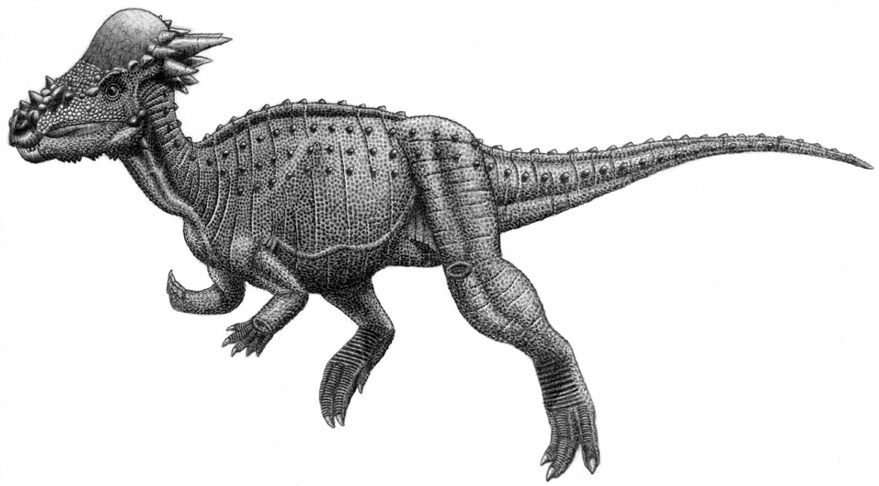
Name Meaning: Head Lizard
Size: 14 feet long
Diet: Plants
Fossil Range: Late Cretaceous
A more unusual looking Dinosaur, Pachycephalosaurus was also one of the last Dinosaurs to die out.
Pachycephalosaurus is only known from a few skull fragments, but close study of other similar Dinosaur species have ultimately allowed experts to build a reasonable picture of how the animal would have behaved.
Pachycephalosaurus had a reinforced dome on the top of its head, that experts believe it may have used to ram rivals, like a modern day bighorn sheep. It may also have used this tactic to defend itself against smaller predatory Dinosaurs such as Raptors and Dromeosaurs.
Some experts however have disputed that they would have rammed each other head on, and may have instead charged at their victims side or underbelly instead.
In Popular Culture
Pacycephalosaurus despite its unique appearance, is sadly often left out of most works about Dinosaurs. However it did make a memorable appearance in The Lost World: Jurassic Park, where it is shown to be powerful enough to ram a man through two windows.
8/ Utahraptor

Name Meaning: Utah’s Predator
Size: 19 Feet Long
Diet: Iguanodon’s and Therenziosaurs
Fossil Range: Early Cretaceous
Utahraptor was a large Dromeosaurid bigger than a Polar Bear. It was closely related to other famous killers such as Deinonychus and Velociraptor (as well as modern day birds.)
Utahraptor was not the fastest of the Dromeosaurs however, so it would it may have relied on ambush tactics to catch smaller prey instead.
Utahraptor could have killed larger herbivores by jumping onto them, using its sickle like claw to mount its victims, whilst it tore chunks of flesh off with its powerful jaws.
It is believed that Deinonychus, a much smaller Dromeosaur had a bite stronger than a modern day Crocodile, so a Utahraptors bite could have been over twice as strong.
Like all Dromeosaurs, Utahraptor would most certainly have been covered in feathers too.
In Popular Culture
The first fragments of Utahraptor were discovered in 1975, but it wouldn’t be until after Jurassic Park in the 90s that they would be given greater attention and the beast was actually named.
Utahraptor for a while became one of the most popular Dinosaurs, as it was actually closer to the Velociraptors of Jurassic Park, than the actual Velociraptors were. In truth it was actually far larger and more powerful than the Raptors of Jurassic Park and may even have been as smart too, well as smart as the Raptors of the first film, not the talking Raptors from the third.
Ultimately however the name Velociraptor had more staying power and so most standard raptors in popular culture are still called Velociraptor. Still Utahraptor has gone on to make a few prominent appearances in popular culture nevertheless.
In Walking with Dinosaurs a pack of Utahraptors are shown to hunt an Iguanodon. Like many reconstructions the documentary assumes the Dromeosaurs to have been pack hunters, also the fact that the episode is set in Europe makes it a little odd that there are Utahraptors at all. (Key’s in the name UTAHraptor.) Still its a thrilling sequence nonetheless.
Utahraptor was also the star of the novel Raptor Bed by paleontologist Bob Bakker which tells the story of a female Utahraptor trying to survive after her pack has been killed off.
Finally Utahraptor also appeared in Primeval New World where it was shown to battle a Pteranodon.
Raptors also appeared in several episodes of the earlier British version of Primeval. However they were never identified. They did match Utahraptor in terms of size, but it was never stated for sure whether they were Utahraptors, Deinonychus’ or even just oversized Velociraptors like in Jurassic Park.
Still since they matched Utahraptor in size then what the hell. Here’s to the Primeval Raptors, my favourite Raptors after the Jurassic Park ones. In a foreshadowing of Blue from the Jurassic World series. Primeval often ironically cast the Raptors in heroic roles, albeit unintentionally, such as when a Raptor kills Emily’s abusive husband, or in season 3 when a Raptor kills Helen Cutter and ironically saves the human race in the process.
7/ Diplodocus

Name Meaning: Double Beam
Size: Over 100 tons, 105 feet long
Diet: Plants
Fossil Range: Mid to Late Jurassic
Diplodocus was a sauropod and possibly the longest Dinosaur of all time. The most extreme estimates for Diplodocus put its top length at 175 feet long!
Diplodocus was not like Brachiosaurus in that it could not raise its neck to feed on the very tops of trees and instead would have primarily browsed low level vegetation.
The Diplodocus’ could live for over 100 years, and at full size would have been too big for most predators, though it is believed that the likes of Allosaurus at the very least preyed on their young.
Like many Sauropods, Diplodocus was most likely a herding animal. It is also known to have swallowed stones to help it digest its food too.
In Popular Culture
One of the most famous Sauropods, Diplodocus has appeared in numerous films, books and documentaries about Dinosaurs over the decades, including Walking with Dinosaurs.
A Diplodocus specimen named Dippy stood for over 100 years as star attraction in the British museum. When the decision was made to replace it in 2017 with a Blue Whale named Hope, there was a massive outcry from the public, but Dippy has since gone on tour around the world.
6/ Triceratops

Name Meaning: Three Horned Face
Size: 12 tons, 35 feet long
Diet: Plants
Fossil Range: Late Cretaceous
The largest and most famous of the Ceratopsian Dinosaurs. Triceratops was also among the last Dinosaurs to go extinct.
Triceratops’ famous frill was incredibly thick and strong compared to those of other Ceratopsians, whilst the two horns above its eyes were over 8 feet long.
Triceratops naturally used its horns and frill to defend itself from Tyrannosaurus Rex, its main predator. Contrary to popular belief, Triceratops did not charge at its victim like a Rhino. Whilst the horns were strong, its beak was quite fragile and would have broken had it charged head on.
Triceratops instead would have gored its victims to death by swinging its head from side to side. Whilst Triceratops did fall victim to Tyrannosaurus Rex, it would have been too big and powerful for the Dromeosaurs it also lived alongside.
However whilst Triceratop’s horns and frill were primarily used to fight off giant predators, experts believe that they may also have been used by males to wrestle with one another over a mate, and for display.
In Popular Culture
Triceratops is one of the most famous Dinosaurs. In popular culture it is almost always depicted as the archenemy of Tyrannosaurus Rex. Unlike other Dinosaur feuds on screen however such as T rex and Stegosaurus, Tyrannosaurus and Triceratops actually did live alongside one another, and regularly fought each other.
Fossil evidence shows that Rexes fought Triceratops head on just like the movies too (though undoubtedly it would have ambushed Triceratops in many instances, with Triceratops frill blocking off its vision behind, allowing the much faster Tyrannosaur to sneak up on it.)
Still we know that Tyrannosaurs if need be were willing to bite at the horns and frill of its enemy, as one Triceratops skeleton has Tyrannosaur bite marks on its frill that have healed, with one of the Triceratops’ horns having bitten in half by the Tyrannosaur too. In addition to this horn marks from Triceratops that have healed have been found on Tyrannosaur skeletons too.
Triceratops has often been depicted battling other large predators such as Allosaurus and Ceratosaurus in popular culture too, though neither of these animals lived beside it.
Among Triceratops’ most notable film appearances include The Ghost of Slumber Mountain, possibly the first ever Dinosaur film, with the effects (and story) supplied by Willis O’Brien, Triceratops would later go on to appear in his 1925 version of The Lost World as well.
Triceratops also appeared in Ray Harryhausen’s iconic film One Million Years BC, where for once it is shown to triumph over its large meat eating rival, in this case a Ceratosaurus, that it gores to death. This fight sequence was arguably Harryhausens most famous moment, alongside his legendary Skeleton fight, and would go on to appear in numerous Documentary’s over the years as an example of how Tyrannosaurus and Triceratops may have fought one another.
A baby Triceratops named Cera also appeared as one of the main characters in the iconic Land Before Time series, whilst the animal also made a memorable appearance in the first Jurassic Park movie where it prompted the creation of one of Jeff Goldblum’s most notorious memes.
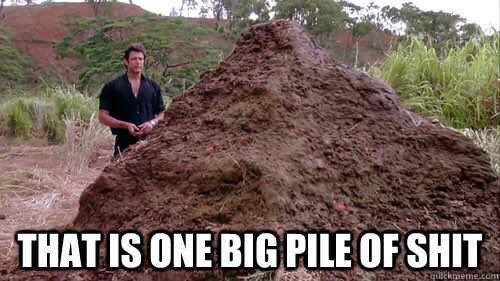
Jeff Goldblum has to have inspired more memes than any other actor from this film alone. Practically every line out of his mouth in the original Jurassic Park has become a meme.
Triceratops would also go on to appear in all of the sequels too, with its largest role being in The Lost World Jurassic Park.
Sadly however its never been shown on screen with its real life nemesis Tyrannosaurus Rex in the Jurassic Park movies yet.
5/ Giganotosaurus
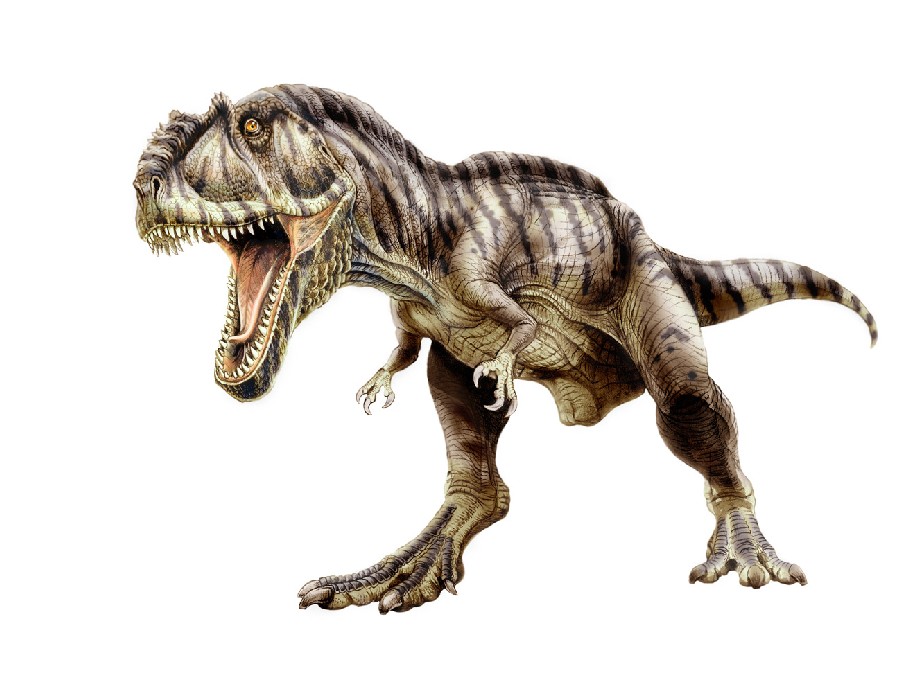
Name Meaning: Giant Southern Lizard
Size: 45 feet long, 13 tons
Diet: Sauropods, Iguanodon
Fossil Range: Early to Mid Cretaceous
Giganotosaurus was an Allosaur, and believed to be one of the biggest meat eating Dinosaurs of all time.
Giganotosaurus broke Tyrannosaurus’ record as the largest land based predator that it had held for over 90 years, but Giganotosaurus was only slightly larger than its more famous North American however, and since then Spinosaurus, which is a good bit bigger than both has now taken the title for the worlds largest meat eating Dinosaur.
Giganotosaurus was the apex predator in its region. Having a bite impact of over 3 tons, and being able to run at over 30 miles per hour, it was a surprisingly nimble creature, considering its size.
Giganotosaurus would have preyed on Argentinosaurus, possibly among the largest land animals of all time, though smaller herbivores such as Iguanodon would have probably been more frequent targets. T
In Popular Culture
Giganotosaurus quickly made a huge impression as the Dinosaur bigger than T. rex and has appeared in many films and television series, though its place as the biggest meat eater of all time was quickly usurped by Spinosaurus in 2006.
Still Giganotosaurus has made a few noteworthy appearances in popular culture over the years. In The Land Before Time 5, The Mysterious Island, Giganotosaurus appears as the main antagonist, where it is eventually defeated by the heroic Tyrannosaur, Chompers father.
Giganotosaurus also appeared in Primeval, where it was dubbed “G-Rex”. This episode is definitely one of my favourites, with the G-Rex looking absolutely spectacular. The script also manages to demonstrate both the Dinosaurs speed and strength perfectly.
Giganotosaurus also appears in the video game ARK. Here it is actually depicted as being considerably larger than both Tyrannosaurus and Spinosaurus.
4/ Deinonychus
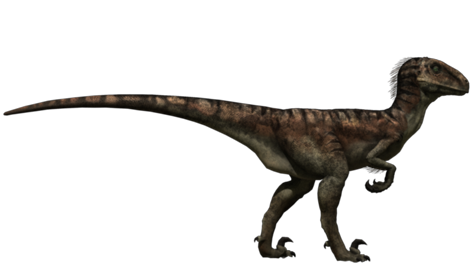
Name Meaning: Terrible Claw
Size: 12 feet long
Diet: Small Mammals, and Dinosaurs
Fossil Range: Late Cretaceous
Deinonychus was a medium sized Dromeosaur. Once believed to have been a pack hunter, capable of taking down giant Dinosaurs such as Tenontosaurus, many experts now think Deinonychus was a more solitary killer.
Like many other Dromeosaurs, Deinonychus had a long sickle like claw on its foot, whilst it had a bite force of over 1 ton, stronger than any Mammalian carnivore.
Much like Velociraptor it is believed that Deininonychus would have killed its victims by scaling tall trees, and then gliding down onto its preys backs, where its claws would hold them down, whilst it literally ate them alive with its jaws. It would also have used its sickle like claw to pierce its victims necks.
Deinonychus is one of the most important Dinosaurs in the history of Palaeontology. John Ostrom’s extensive study of Deinonychus in the 1960s led to what has been dubbed the Dinosaur renaissance in the 1970s.
Ostrom concluded that some Dinosaurs were warm blooded, agile, fast and intelligent creatures. He also revived the old argument that birds evolved from small meat eating Dinosaurs.
Ostrom’s ideas were controversial at first, but they have now become accepted. Prior to Ostrom’s studies of Deinonychus, Dinosaurs were thought of as slow moving, slow witted, sluggish reptiles, but Deinonychus paved the way for the depiction of clever, fast moving, Dinosaurs in both science and popular culture.
In Popular Culture
Following the Dinosaur Renaissance, Deinonychus would go on to become quite popular for many years before ultimately being usurped by Velociraptor.
It featured in works such as the card series Dinosaur Attack, the Marvel comic book Devil Dinosaur, and the Christopher Reeve documentary, Dinosaur.
Michael Crichton also intended to use Deinonychus in his classic novel, Jurassic Park as the main predatory Dinosaur. However at the last minute he decided to change it to Velociraptor, as he felt it had a better name, and at that point Deinonychus was believed to be a member of the Velociraptor family (which is explicitly stated in the novel, which technically does make the Dinosaurs of the novel Deinonychus anyway.)
However in the film adaptation they were just named Velociraptor, (despite being closer in size and behaviour to Deinonychus. )
Thus Velociraptor shot to fame, but in actual fact the classic Raptor image in films, television and comic books is really of Deinonychus.
Still most Raptors are often referred to as Velociraptors, and Utahraptors instead.
3/ Allosaurus
Name Meaning: Odd Lizard
Size: 35 feet long, 3 tons
Diet: Sauropods, Stegosaurs, Pterosaurs, Smaller Dinosaurs and Mammals.
Fossil Range: Mid to Late Jurassic
The lion of the Jurassic. Allosaurus was a large, very fast and successful predator that was capable of killing herbivores many times its own size.
Allosaurus may have been able to run at speeds of 35 miles per hour and was very agile for an animal its size.
When hunting large Sauropods, Allosaurus would have jumped through the air and scaled its victims using the claws on its hands and feet, as seen here in Walking with Dinosaurs.
Allosaurus was an incredibly durable animal too, with one specimen of a male sub adult Allosaurus having 19 severe injuries almost all of which had healed.
Allosaurus did not have strong jaws however. In fact its bite force was weaker than that of many modern day predators such as Leopards.
Instead it is believed that Allosaurus used its head like a hatchet against its enemies. Allosaurus could open its jaws wider than any other Dinosaur, and its skull was among the strongest and most reinforced of any theropod too.
This method would have allowed Allosaurus to cleave off greater sections of flesh from its prey than most other theropods.
Some experts however have called the hatchet method into question. A more recent study suggested that Allosaurus may have opened its mouth extra wide to give it a powerful bite, in place of strong jaw muscles.
Whatever the truth, Allosaurus was both a powerful and effective predator that specialised in taking down some of the largest creatures ever to walk the earth.
In Popular Culture
Allosaurus is one of the most famous Dinosaurs. Though not quite as popular as Tyrannosaurus, in many ways it has come to represent the quintessential giant meat eater after T. rex, even above much larger killers such as Spinosaurus and Giganotosaurus.
Allosaurus appeared as the dominant carnivore in Sir Arthur Conan Doyle’s novel The Lost World, and the later 1925 adaptation. Though a Tyrannosaurus also appears in the 1925 version, it is only in a single sequence.
Allosaurus also appeared as the main (and sole) Dinosaur in The Beast From Hollow Mountain, a rare fusion of the Western and Dinosaur genres.
Beast From Hollow Mountain’s effects were supplied by Willis O’Brien who also supplied the effects for King Kong and the original 1925 version of The Lost World. O’Brien also came up with the concept too.
The later Dinosaur Western, The Valley of the Gwangi, also featured an Allosaurus as the titular Dinosaur, though actually according to Ray Harryhausen, who supplied the films effects, Gwangi was intended to be a hybrid of Tyrannosaurus and Allosaurus which he dubbed “Tyrannosaurus Al.”
Allosaurus also appeared in One Million Years BC where it is shown to attack a tribe of Cavemen. Here it is made much smaller and weaker than an actual Allosaurus as Ray Harryhausen himself said that a real Allosaurus would have destroyed the village with no effort.
I know the uploader got it wrong and called it a Velociraptor, but its an Allosaurus.
A female Allosaurus named Big Alice also appears as a major, recurring antagonist in the 1970s tv series, The Land of the Lost.
Another major appearance of Allosaurus is in Walking with Dinosaurs. Not only does it appear in the second episode, but it is also the focus of the Christmas special called The Ballad of Big Al which details the life of a young male Allosaurus.
Allosaurus also appeared in the 2001 adaptation of The Lost World, made my the same team behind Walking with Dinosaurs and later Primeval.
Interestingly enough despite Allosaurus’ popularity, it wasn’t until the 5th entry in the Jurassic Park series that Allosaurus finally made an appearance.
2/ Spinosaurus
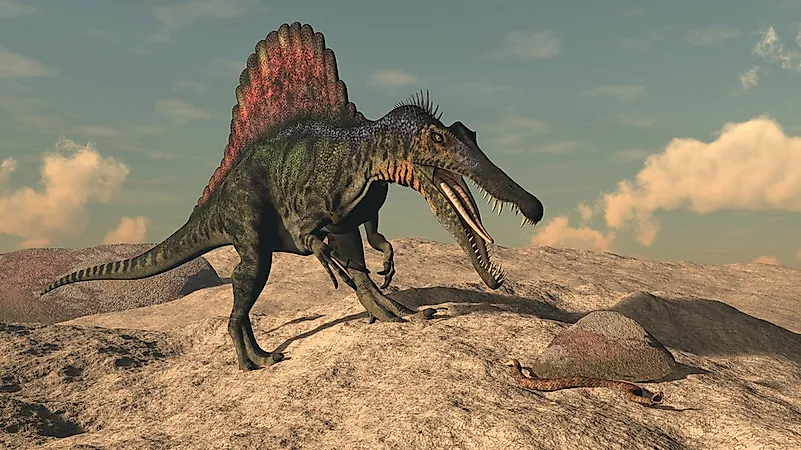
Name Meaning: Spine Lizard
Size: 59 feet long, 23 tons
Diet: Fish, Large and Small Dinosaurs, Pterosaurs
Fossil Range: Early to Mid Cretaceous
The largest land based predator ever to live on the planet, Spinosaurus may actually have been semi aquatic and walked on all fours. There is much that is still not known about this predator, with the causes of its famous sail still being a subject of debate, though most experts believe that sail was used either to regulate body temperature or to attract a mate.
Spinosaurus had long thin jaws, and whilst its bite was stronger than any modern day predator, it was still weaker than many other large meat eating Dinosaurs. Still Spinosaurus had the largest claws of any meat eating Dinosaur on its hands. They were long and thicker than the meat hooks in a slaughter house. Biomechanical reconstructions of Spinosaurus’ claws have shown that they would have been powerful enough to shred through solid bone and steel.
Spinosaurus would have easily been able to disembowel the largest herbivores it shared its habitat with. Despite this however many experts believe that Spinosaurus would have preyed primarily on marine life. Though some have knocked it as not being as impressive as other predators because of this, Spinosaurus would have regularly preyed on sharks and fish, larger and more powerful than modern day Great Whites.
Spinosaurus was an apex predator, but it is known that it shared its environment with two other large carnivores, Carcharcodontosaurus and a crocodile named Sarcosuchus. Whilst all three carnivores would have most likely avoided each other most of the time, there is some evidence that all three did fight one another on occasion.
In Popular Culture
Spinosaurus remained a relatively obscure Dinosaur for decades until it literally shot to fame overnight thanks to the 2001 movie Jurassic Park 3, where it was cast as the main antagonist. Though controversial, the movie helped Spinosaurus take Giganotosaurus’ place as the meat eating Dinosaur bigger than the T. rex. This position was really cemented when its true size was finally discovered in 2006.
Since then Spinosaurus has gone on to appear in numerous, films, comic books and television series including Dinosaur Planet, ARK, the Transformers film series and Primeval.
It’s not hard to see why Spinosaurus has become so popular. Not only is it officially the biggest of all meat eating Dinosaurs, but it’s also among the most spectacular looking too. With its crocodile like head, and massive sail, its almost looks like a Dragon from Medeval mythology.
1/ Tyrannosaurus Rex

Name Meaning: Tyrant Lizard King
Size: 40 feet long, 10 tons
Diet: Hadrosaurs, Ceratopsians, Sauropods, Anklyosaurs
Fossil Range: Late Cretaceous
Okay obvious choice, but that’s only because it’s such a special animal. Tyrannosaurus Rex practically needs no introduction. It is the most famous Dinosaur of them all. Once thought to be the largest land based predator of all time, T. rex was still nevertheless the apex predator of its environment, and preyed on the likes of Triceratops, Anklyosaurus and Alamosaurus, a gigantic Sauropod. It was also one of the last non avian Dinosaurs to go extinct.
Tyrannosaurus Rex had the strongest bite force of possibly any animal ever to live on the planet, and certainly the strongest of any Dinosaur.
Bio mechanical reconstructions of a T. rex skull for the 2005 documentary The Truth About Killer Dinosaurs, showed that the animal would have had a bite force of over 4 tons. Not only is this greater than any animal alive today, but it would have meant that T. rex’s skeleton would had to have been stronger than reinforced steel in order to withstand the pressure. The animal would also easily have been able to rip up a small car in its jaws no problem.
See here.
Further studies however, including by Gregory Erickson who worked on this documentary, have shown that it’s results were wrong. Tyrannosaurus would have actually had a bite over twice as strong as The Truth About Killer Dinosaurs claimed. T. rex’s actual bite force was possibly over 9 tons.
Earlier studies by Mason B Meers meanwhile put Tyrannosaurus Rex’s bite force at over 23 tons.
If this were true, then T. rex would have had the strongest bite force of any animal, even greater than the Megalodon shark. A bite of 23 tons would also give Tyrannosaurus a bite force 7 times great than that of Giganotosaurus and over 10 times greater than that of Spinosaurus.
The most commonly accepted estimate for a Tyrannosaurus bite force is over 6 tons which still gives it a stronger bite than any other meat eating Dinosaur.
In addition to being able to bite with more force, Tyrannosaurus could rip off over 500 pounds of flesh from its victims in just one bite.
Tyrannosaurus was also an incredibly durable animal overall. Many Tyrannosaur skeletons have been found with gruesome injuries, which would have been fatal to other animals, that have still nevertheless healed. These include whacks made by Anklyosaur clubs (that could swing with a force of over 4 tons), scratches made by Triceratops horns, and bite marks made by other T. rex’s. In one instance one Tyrannosaurus skull has a bite mark made in its brain case which has still nevertheless healed, whilst another specimen appears to have healed from a broken neck!
Aside from its power. Tyrannosaurus was also a very intelligent Dinosaur too. Its brain was considerably larger than any other big meat eater, and more recent studies have shown that Tyrannosaurus may actually have been more intelligent than a Chimpanzee.
Tyrannosaurus’ advanced intelligence enabled it to have far more refined senses too. Its eye sight was far superior to modern day birds of prey such as Eagles, whilst its sense of smell according to Bob Bakker would have been comparable to 100 blood hounds.
Finally Tyrannosaurus could also run faster than most of its intended prey species such as Triceratops. Its top speed was at roughly 18 miles per hour. Though slower than other large carnivores such as Giganotosaurus and Allosaurus, it was faster than other large animals, including modern day elephants.
Tyrannosaurus Rex was the last and largest in a long line of meat eating Dinosaurs called the Tyrannosaurs, who initially began as small meat eating Dinosaurs in the Jurassic, but gradually over the course of several million years they evolved into giant killers, and out competed other groups of large meat eating Dinosaurs in any area they appeared in. By the end of the Cretaceous period the Tyrannosaurs were unquestionably the dominant large meat eaters, but sadly they would be driven to extinction along with all of the other non avian Dinosaurs at the end of the Cretaceous period 66 million years ago.
Still its somewhat fitting that at the very end of their reign over the earth, the Dinosaurs evolved the most sophisticated and dangerous predator ever to walk the earth.
Whilst it may no longer be considered the largest land based predator of all time, Tyrannosaurus Rex is still utterly unsurpassed among the giant killers in terms of intelligence and sheer power.
In Popular Culture
Where to begin! Tyrannosaurus Rex is the most famous Dinosaur of them all. It has appeared in The Lost World (1925), King Kong, Dinosaurus, The Valley of the Gwangi, all versions of The Land of the Lost, Jurassic Park, The Lost World Jurassic Park, Jurassic World, Walking with Dinosaurs, and Primeval.
It would take too long to run through all of the big guys appearances on the small and big screen, so I’ll just show you some of his greatest hits here.
Thanks for reading.
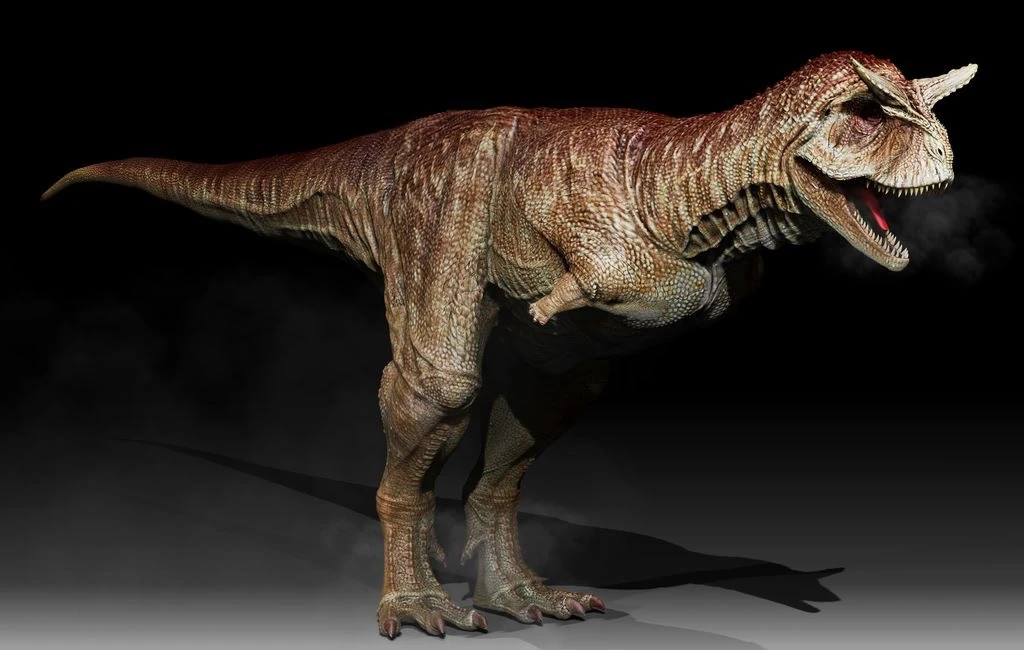


Hey! Long time no see. Sorry ’bout that. Anyway, this was a really good idea for an article! That theory about the Dinosauroids was quite interesting. I personally favor the Stegosaurus.
LikeLike
Driptosaur beats all
LikeLike
I love Dilophosaurus their amazing! Stegosaurus is great too>
LikeLike